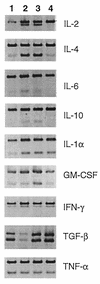Treatment of mice with staphylococcal enterotoxin B enhances resolution of an induced Escherichia coli urinary tract infection and stimulates production of proinflammatory cytokines
- PMID: 9596704
- PMCID: PMC108226
- DOI: 10.1128/IAI.66.6.2466-2470.1998
Treatment of mice with staphylococcal enterotoxin B enhances resolution of an induced Escherichia coli urinary tract infection and stimulates production of proinflammatory cytokines
Abstract
Staphylococcal enterotoxin B (SEB) is a superantigen that causes mass proliferation of murine Vbeta8+ T cells via major histocompatibility complex (MHC) class II molecules and leads to their apoptosis or anergy. SEB also stimulates other MHC class II-bearing cells to proliferate and secrete cytokines, some of which might enhance early host defenses against urinary tract infections (UTIs). We investigated the effect of SEB administration on the course of an induced Escherichia coli UTI in mice. Treatment with SEB 3 or 7 days before the infection had no effect on UTI resolution. However, when SEB was administered at the time of infection, bacterial colonization in the bladders was reduced at time points between 6 h and 3 days. This reduction was not due to a physiological effect, such as increased urinary glycosaminoglycans, or altered pH, nor was SEB bactericidal for the inoculum. Cytokine production in the spleens and bladders of SEB-treated and/or infected mice was evaluated by reverse transcription-PCR. SEB treatment resulted in increased levels of interleukin-2 (IL-2), IL-4, IL-6, and IL-10 mRNAs in the spleen and IL-1alpha, IL-6, granulocyte-macrophage colony-stimulating factor, and tumor necrosis factor alpha transcripts in the bladder. Also, liver cells from SEB-treated mice expressed IL-6 mRNA, which induces the production of acute-phase proteins. These data indicate that SEB treatment in vivo leads to enhanced UTI resolution through a mechanism that may include direct stimulation of effector cells in the bladder, the action of cytokines induced in the spleen, or cytokine-mediated induction of acute-phase proteins.
Figures




Comment in
-
Reflux in the mouse model of urinary tract infection.Infect Immun. 1998 Dec;66(12):6063-4. doi: 10.1128/IAI.66.12.6063-6064.1998. Infect Immun. 1998. PMID: 9874598 Free PMC article. No abstract available.
Similar articles
-
Unique cytokine production profile of anergic human T cells in SCID-hu mice after staphylococcal enterotoxin B administration.J Immunol. 1995 Apr 1;154(7):3204-12. J Immunol. 1995. PMID: 7534791
-
Effect of treatments with cyclosporin A and anti-interferon-gamma antibodies on the mechanisms of immune tolerance in staphylococcal enterotoxin B primed mice.Scand J Immunol. 1997 Nov;46(5):459-68. doi: 10.1046/j.1365-3083.1997.d01-152.x. Scand J Immunol. 1997. PMID: 9393628
-
Increased mortality and impaired clonal deletion after staphylococcal enterotoxin B injection in old mice: relation to cytokines and nitric oxide production.Scand J Immunol. 1997 Nov;46(5):469-78. doi: 10.1046/j.1365-3083.1997.d01-153.x. Scand J Immunol. 1997. PMID: 9393629
-
Staphylococcal Superantigens Spark Host-Mediated Danger Signals.Front Immunol. 2016 Feb 2;7:23. doi: 10.3389/fimmu.2016.00023. eCollection 2016. Front Immunol. 2016. PMID: 26870039 Free PMC article. Review.
-
Staphylococcal Superantigens: Pyrogenic Toxins Induce Toxic Shock.Toxins (Basel). 2019 Mar 23;11(3):178. doi: 10.3390/toxins11030178. Toxins (Basel). 2019. PMID: 30909619 Free PMC article. Review.
Cited by
-
Bacterial superantigen-treated intestinal epithelial cells upregulate heat shock proteins 25 and 72 and are resistant to oxidant cytotoxicity.Infect Immun. 2004 Jun;72(6):3187-94. doi: 10.1128/IAI.72.6.3187-3194.2004. Infect Immun. 2004. PMID: 15155620 Free PMC article.
-
Antimicrobial activity of intraurethrally administered probiotic Lactobacillus casei in a murine model of Escherichia coli urinary tract infection.Antimicrob Agents Chemother. 2001 Jun;45(6):1751-60. doi: 10.1128/AAC.45.6.1751-1760.2001. Antimicrob Agents Chemother. 2001. PMID: 11353622 Free PMC article.
-
Reflux in the mouse model of urinary tract infection.Infect Immun. 1998 Dec;66(12):6063-4. doi: 10.1128/IAI.66.12.6063-6064.1998. Infect Immun. 1998. PMID: 9874598 Free PMC article. No abstract available.
References
-
- Amura C R, Fontan P A, Sanjuan N, Sordelli D O. The effect of treatment with interleukin-1 and tumor necrosis factor on Pseudomonas aeruginosa lung infection in a granulocytopenic mouse model. Clin Immunol Immunopathol. 1994;73:261–266. - PubMed
-
- Appelberg R. Protective role of interferon gamma, tumor necrosis factor alpha and interleukin-6 in Mycobacterium tuberculosis and M. avium infections. Immunobiology. 1994;191:520–525. - PubMed
-
- Baschieri S, Lees R K, Lussow A R, MacDonald H R. Clonal anergy to staphylococcal enterotoxin B in vivo: selective effects on T cell subsets and lymphokines. Eur J Immunol. 1993;23:2661–2666. - PubMed
-
- Bell S J D, Buxser S E. Staphylococcal enterotoxin B modulates Vβ8+ TcR-associated T-cell memory against conventional antigen. Cell Immunol. 1995;160:58–64. - PubMed
-
- Cassatella M A. The production of cytokines by polymorphonuclear neutrophils. Immunol Today. 1995;16:21–26. - PubMed
Publication types
MeSH terms
Substances
Grants and funding
LinkOut - more resources
Full Text Sources
Medical
Research Materials

